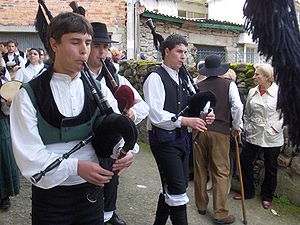Galician
| Galician Galegos | |
|---|---|

|
|
| Total population | about 2.7 million |
| Settlement area | Galicia |
| language | Galician , Spanish |
| religion | Catholic Christians |
Galicians (Galician galegos , Spanish gallegos ) are the members of an Iberian compatriot or ethnic group , which consists of the historical and modern inhabitants of today's autonomous region of Galicia in northwestern Spain .
population
The Galicians make up around 6.5 percent of the Spanish population with around 2.7 million inhabitants. Many Galicians speak next to the Spanish since the early 1980s as a regional official language recognized language Galician belonging to the Ibero-Romance languages heard and closely with the Portuguese is related.
ancestors
The inhabitants of what is now Galicia and northern Portugal were called Gallaekers in Roman times , from whom Galicia takes its name. Their origin is hardly clear, it is likely to have been relatively weakly Celtic Indo-European ethnic groups that were Roman colonized and Romanized. From prehistoric times several invasions by Nordic peoples are assumed for Galicia and its neighboring regions, which must have started before the first millennium BC. Because of these contacts, the region in the west of the Iberian Peninsula north of the Tagus was Europeanized at least since the Late Bronze Age . Until the Roman conquest, the north-west of the peninsula belonged to the area of distribution of the so-called Castro culture , which, however, left hardly any evidence in today's Galicia itself.
During the migration of the peoples , the Suebi established a Galician kingdom with the capital Braga in the 5th century , which remained an independent unit even after it was incorporated into the Visigothic Empire towards the end of the 6th century. The Moorish conquest of Hispania left little marks in Galicia, as the area became part of the rebellious Christian kingdom of Asturias after a few decades of Muslim administration .
Ethnogenesis of Portugal
Galicians were instrumental in the ethnogenesis of the Portuguese in the Middle Ages . As a result of the dynastic secession of the southern counties from the kingdoms of Galicia and León and the Reconquista operated independently by the Portuguese rulers, the ethnic branches north and south of today's Spanish-Portuguese border separated from the 12th century.
Emigrants
An early wave of Galician migration began as early as the 18th century when thousands of Galicians migrated to Andalusia , Castile and Portugal to work as day laborers for large landowners or in the cities as servants or water carriers . The main phase of Galician emigration overseas began around 1860 and lasted until 1936, when emigration was stopped by the Francoist regime. Migration was strongly male, women and children often stayed behind in Galicia.
Between 1885 and 1930 more than 900,000 Galicians emigrated to Latin America , and in many individual years of this period they made up the largest contingent of Spanish emigrants. The main reason was the rampant poverty in the rural and underdeveloped Galicia. More than half of the Galician emigrants moved to Argentina ; almost a third emigrated to Cuba ; The third most important destination country was Brazil . Galician immigrant communities continue to have significant cultural influence in many Latin American countries.
Galician migration within Europe began on a massive scale in the 1960s and already weakened in the early 1970s. The most important destinations for Galician guest workers were Switzerland , Great Britain and West Germany , and there was also significant Galician labor migration to Benelux and France . At the same time there was a strong Spanish internal migration of Galicians who found work in the industrial metropolises of the Basque Country and Catalonia as well as in Madrid .
Known Galicians
- Known people of Galician descent
- Rosalía de Castro - writer
- Camilo José Cela - writer, Nobel Prize winner
- Fidel Castro - Head of State of Cuba (his father Ángel Castro Argiz was a Galician)
- Miguel Colmeiro - botanist
- Julio Iglesias - singer, entertainer (his father Julio Iglesias Puga comes from Ourense , Galicia; he was born in Madrid )
- Francisco Franco - dictator
- José Calvo Sotelo - politician
- Manuel Fraga Iribarne - President of the Xunta de Galicia from 1989 to 2005
- Mariano Rajoy - politician
- Amancio Amaro - football player
- Luis Suárez - football player
- Míchel Salgado - football player
- Fernando Torres - soccer player; his parents are Galician emigrants, Torres himself was born in a suburb of Madrid
- Jorge Lorenzo - motorcycle racer; his father is an emigrated Galician ( A Coruña )
- Óscar Pereiro - cyclist
- Paulina Rubio - singer, entertainer (father Enrique Rubio comes from A Coruña )
- Martin Sheen - American actor (Father Francisco Estévez is from Parderrubias)
- Carlos Núñez - Celtic folk musician
- Barreiros - former Spanish industrial company from Ourense
- Amancio Ortega Gaona - Spanish textile entrepreneur Inditex various textile companies including Zara
Individual evidence
- ↑ Lexicon of Romance Linguistics (LRL), Volume 6.2 (Galegic, Portuguese), Tübingen 1994, p. 81.
- ↑ Willi Stegner (ed.): Pocket Atlas Völker und Sprachen. Klett-Perthes, Gotha 2006, ISBN 978-3-12-828123-0 , p. 60.
- ↑ a b El gallego en el mundo. Online publication on galego.org , accessed July 2018 (Spanish).
- ↑ José Ramón Campos Álvarez: La emigración gallega a América (1880-1930). Integración y retorno (PDF; 456 kB). In: Minius 2/3 (1993/1994), pp. 133-145 (here: 135 f.).











